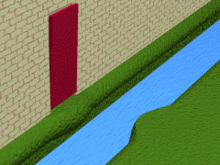Kinetic architecture
A building's capability for motion can be used just to: enhance its aesthetic qualities; respond to environmental conditions; and/or, perform functions that would be impossible for a static structure.
The possibilities for practical implementations of kinetic architecture increased sharply in the late 20th century due to advances in mechanics, electronics, and robotics.
Yet it was only in the early 20th century that architects began to widely discuss the possibility for movement to be enabled for a significant portion of a buildings' superstructure.
For the first few decades of the 20th century kinetic architecture was almost entirely theoretical, but by the 1940s innovators such as Buckminster Fuller began experimenting with concrete implementations, though his early efforts in this direction are not regarded as totally successful.
The bird-like Burke Brise soleil at the Milwaukee Art Museum is a well regarded example of this, though it also has a functional aspect in that its movement allows it to shade the crowds from the sun or protect them from storms.


